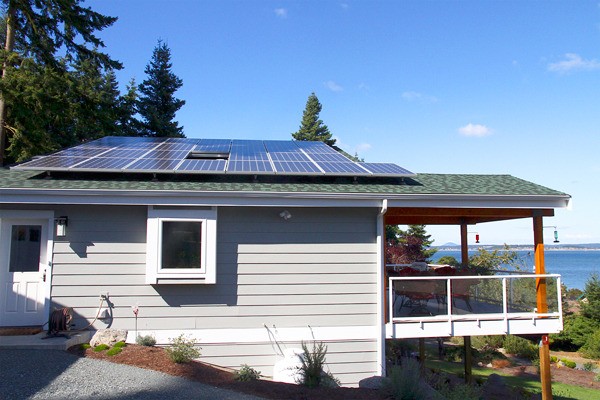Steve and Janine Shelley are making money from their new Coupeville home, they said during a recent visit.
The 2,400-square-foot, two-story home, designed by Clifton View Homes, produces four percent more power than it consumes, the Shelleys said.
“It’s a very easy house to live in,” Janine Shelley said. “It’s not big, but it’s big enough. It’s comfortable. The views are amazing, and we pretty much run our Chevy Volt for free with the surplus power we create.”
The house, in the Long Point neighborhood, is one of 11 included in this weekend’s Skagit/Island Counties Builders Association home tour.
“This home worked out very well,” said Ted Clifton, founder of Clifton View Homes, which is a member of the association.
“The energy features to us are kind of automatic. It’s the views that put a big grin on their faces.”
The home’s entire south-facing roof is covered with solar panels, which generate 275 watts each. Its east side, the house’s front, consists mainly of triple-paned glass, allowing the morning sun to help heat the house after cool nights.
All the heating is radiant, which is virtually silent and provides very even heat, the Shelleys said.
Walls above grade are made of 6.5-inch-thick structural insulated panels, and those below grade are made of concrete with foam on both sides.
This unusual construction eliminates the need for energy-leaking studs, Clifton explained.
The roof has no rafters, so the insulated panels up there likewise leak no energy, he said.
The house is so energy-efficient that the Shelley’s end up selling excess power back onto the grid in the summer, buying it only in the winter and enjoying a net gain overall.
“We’ll end up making money year over year,” Steve Shelley said.
Those savings have been verified by an independent ratings agency, Clifton said.
Houses that consume no more power than they create are known as zero-energy homes.
Other firms on the tour design and build in a less energy-efficient fashion, Clifton said.
“It’s not code-required to build like this, nor should it be — it should be the consumer’s choice,” he said. “But the informed consumer wants a house that performs. Why would you pay top dollar for a house that’s not solar-ready and zero-energy-ready?”
“Why not buy this year’s or next year’s model?”
The house complies with requirements of the Americans with Disabilities Act, so the couple “can grow old here,” they said. The upper floor contains a large living room with a propane fireplace, the kitchen, the master bedroom and a good-sized dressing room.
The Shelleys skipped a bathtub in favor of a large, deluxe shower stall. Downstairs are a glass-making studio for Janine, a model-trains room for Steve, a TV room and a guest bedroom and bathroom.
The Shelleys said they paid about $420,000 for the house.



